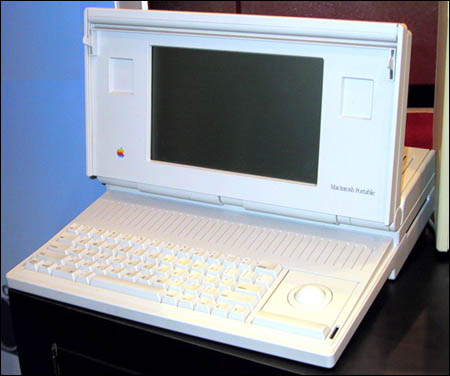This article is more than 1 year old
25 years of Mac - the good, the bad, and the cheese grater
Confessions of a dangerous fanboi
The Five Worst Macs of All Time
Even the most rabid Mac addict, trapped irretrievably in Steve Jobs's reality-distortion field, must admit that Apple has released some true dogs in the past 25 years. Here are five that barked louder than the others:
Macintosh Portable: What a stupid machine. Heavy as a sumo, as big as a Samsonite hard-shell, and so poorly designed that you couldn't even run it on AC power because the battery was charged in series with the AC. When its battery ran down, you were hosed.
And did I mention that it cost $6,500, had a non-backlit LCD display (later upgraded), and was powered by a wimpy 16MHz 68000? The ridicule it engendered was deserved.

Arguably the dumbest Mac of all time
Macintosh IIvx: This mid-range Mac, introduced in October 1992, wasn't strictly a dog - although its 16MHz system bus certainly pushed it in a canine direction - but it did become the only Mac I've known to have gained the honor of becoming a verb.
When the substantially more-capable and less-expensive Centris 650 was introduced a mere four months after the IIvx, buyers of hardware that went quickly out of date were said to have been "IIvxed."
PowerBook 5300: This blocky, bulky PowerBook became the butt of many a joke when rumors circulated that its defective batteries could burst into flame.
While there are conflicting reports as to whether any production units, which used NiMH batteries, ever actually did, there are many reports of pre-production lithium-ion models doing so. No matter - the 5300 suffered from enough other problems to doom it to failure. No Ethernet port? No L2 cache? Hinge and AC-adapter failures? Check.
Despite its many flaws and recalls, however, Jeff Goldblum was able to use a PowerBook 5300 to save the world in Independence Day. So I guess it was worth manufacturing after all.
Power Macintosh 4400: In the deepest, darkest days of Apple's decline, some product-managing whizbang decided it'd be a good idea to construct a low-end, low-cost Mac using off-the-shelf parts designed for Windows PCs.
It wasn't. The Power Macintosh 4400 of November 1996 is widely regarded as one of - if not the - least distinguished Macs of all time. The best thing you could say about it was that it worked. Unless its PRAM battery was dead. In which case it was merely a large, clunky, ugly doorstop.
Twentieth Anniversary Macintosh: If the Power Macintosh 4400 lost points because it lacked the elegance that Mac users demand, 1997's Twentieth Anniversary Macintosh (named for Apple's 20th, not the Mac's) deserves ridicule because it tried too hard to be stylish and demanded such a premium for that stylishness. It debuted at $7,499.
Style is, of course, a subjective concept, but nowhere near enough Mac users were captivated by the TAM's flat-panel display, Bose sound system, external subwoofer, and other niceties to pop $7,499 for it. The price was soon reduced to as low as $1,999, but it was too late. The TAM had muffed its chance and was gone in a year.
Runners-up: Close behind in dogginess are two entire Mac lines: the Power Mac/Performa 5200/5300 and 6200/6300 series of the mid-90s. The mere difficulty in identifying these pooch litters illustrates the confusion facing Mac buyers during that unfortunate time. Among their other warts, the motherboard designs of these Macs crossed a 64-bit chip with a 32-bit bus with exactly the performance hit you'd expect.
Then there's the Power Mac G4 Cube of July 2000. While many stylistas might rank the Cube as one of their five best, for my money - and the Cube wasn't cheap - its glossy transparency didn't make up for its lack of expansion capabilities.
Finally, I'll toss in the original Macintosh, which later became known as the Macintosh 128k. Before you fire off an angry comment, let me remind you that Apple soon agreed with me and raised the original Mac's ludicrously low RAM allotment when it released the 512k "Fat Mac" only eight months later.
By then, a buddy of mine at the Exploratorium had already removed the RAM from our 128k Mac and bumped it up to 512k himself. If you ever tried to copy a floppy on a single-drive 128k Mac, which required an insane amount of disk-swapping as the floppy's contents were loaded into limited RAM, you'd know why. ®
Footnote
(1) Reproduced under the Creative Commons Attribution ShareAlike 2.5 License.
